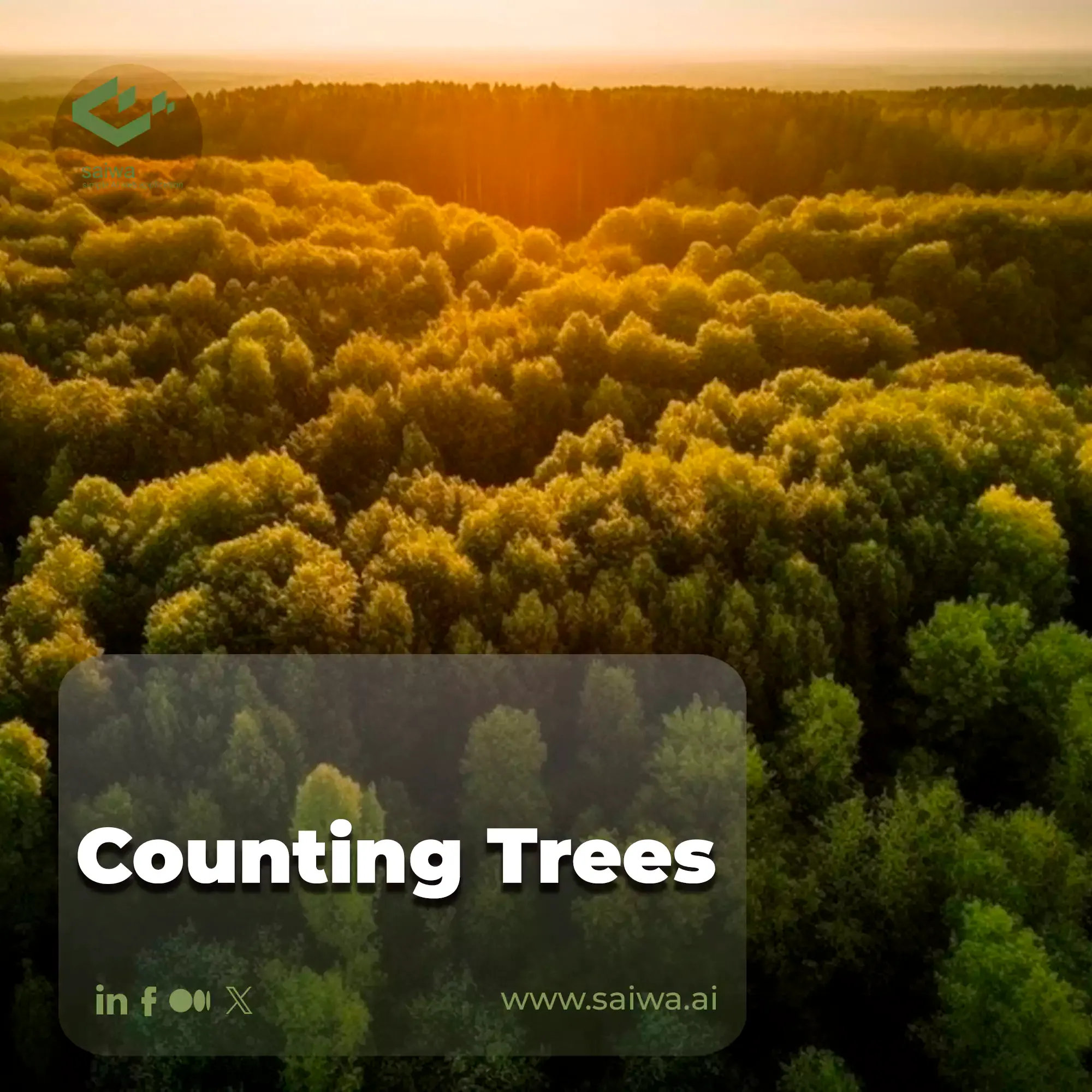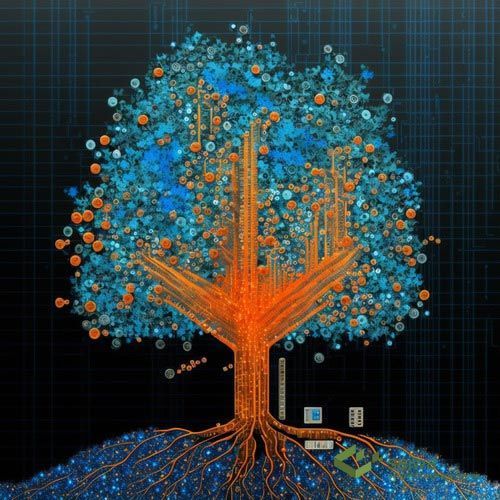Methods of Tree Counting: A Practical Guide on Using AI

Counting trees is an important part of forestry and environmental science. It provides key information that is needed to assess forest resources, manage timber stocks, track carbon levels, and understand the effects of deforestation and other disturbances.
In the past, tree numbers were measured by people going out into the field to count them. This worked well for small areas but not for larger ones. As forestry needed to look at more areas and the whole world, new technologies came in to make things more efficient and accurate.
This guide provides an in-depth look at AI-enabled tree counting, including the technologies behind automated detection, real-world applications in forestry and conservation, and effective implementation approaches.
What Is AI Tree Counting and Why Is It Important?
AI tree counting employs computer vision and machine learning algorithms to automatically detect individual trees within digital imagery captured by drones, satellites, aircraft, or terrestrial laser scanners.
Accurate tree population data proves essential for sustainable forest management, carbon market programs, and biodiversity conservation. Combining tree count data with allometric equations and wood density enables estimation of carbon stored in aboveground woody biomass, critical for REDD+ and other climate mitigation programs avoiding forest loss and degradation.
Methods for Counting Trees
Tree counting supports forest management, environmental monitoring, and sustainable development by helping determine forest density, estimate biomass, track human impacts, and guide conservation and timber planning. Here some methods introduced:
Manual Surveys:
Traditional fieldwork using plots and basic tools to record tree species, size, and counts. Accurate but slow, labor-intensive, and difficult in dense or rough terrain.
Read Also: AI in Forestry | Transforming Sustainability and Conservation
Aerial Photography & Satellite Imaging
Images from planes, drones, or satellites used to estimate canopy density and forest cover. Useful for large areas, but affected by shadows, cloud cover, and canopy overlap. Satellite resolution often limits detection of individual trees.
LiDAR Technology
Laser-based scanning that creates 3D forest models, capturing tree height, canopy structure, and spacing with high accuracy. Excellent for dense forests but expensive at large scales.
Drones & UAVs
Flexible, cost-effective tools capturing high-resolution imagery or LiDAR data for small to medium areas. Ideal for repeat monitoring, though limited by battery life, regulations, and data-processing demands.
AI & Machine Learning
Algorithms automatically detect and count trees from imagery or LiDAR, reducing manual work and improving consistency. Highly scalable but dependent on strong training data and computational resources.
How AI Tree Counting Works
AI-powered tree counting integrates remote sensing data collection with sophisticated image analysis through systematic processes:
- Multi-Source Data Acquisition: High-resolution imagery from drones flown at high altitude captures individual tree crowns clearly, with RGB cameras providing visual detail and multispectral sensors revealing vegetation health. Airborne LiDAR systems emit laser pulses generating three-dimensional point clouds representing canopy structure, penetrating foliage to detect understory layers. In practice, multi-altitude flights may be required to capture both canopy and sub-canopy layers accurately.
- Image processing: Raw imagery undergoes geometric correction, radiometric calibration, and seamless mosaicking from overlapping photos creating unified datasets covering study areas. LiDAR point clouds are filtered separating vegetation returns from ground points, with canopy height models derived subtracting terrain elevation from surface elevations. Additional smoothing and gap-filling steps ensure more accurate crown delineation, particularly in dense forests.
- Deep Learning Model Application: Trained Convolutional Neural Networks analyze preprocessed imagery applying learned patterns to identify tree locations. Object detection models like YOLO or Faster R-CNN predict bounding boxes around individual crowns with associated confidence scores. Model selection depends on application requirements balancing detection precision with computational efficiency. Sairone employs RTMDet, a state-of-the-art object detection and instance segmentation network, to identify and segment individual tree crowns. RTMDet provides fast and robust detection while accurately handling overlapping crowns. Segmentation outputs are combined with 3D LiDAR-derived heights to improve detection in dense areas. Confidence thresholds are adjustable to balance precision and recall based on operational needs.
- Tree Crown Delineation and Classification: Segmentation algorithms partition imagery into tree crown regions using watershed methods, region growing, or neural network predictions. Individual tree detection combines 2D crown delineation from overhead imagery with 3D height information from LiDAR or photogrammetric structure-from-motion, improving accuracy in dense forests where crowns overlap. Species classification modules may identify tree types from spectral signatures or morphological characteristics.
- Validation and Quality Assurance: Automated counts undergo validation comparing predictions to manual field measurements in ground-truth plots established across study areas. Statistical accuracy metrics including precision, recall, and F1-scores quantify model performance, identifying conditions where detection succeeds or struggles. Human experts review detections correcting obvious errors and providing feedback informing model refinement through active learning approaches.
- Integration with Forest Management Systems: Tree count data feeds into Forest Inventory Management Systems and Geographic Information Systems providing spatial representations of forest resources. Automated data pipelines and standardized formats facilitate information flow between AI counting systems and existing management software, enabling seamless integration supporting harvest planning, conservation prioritization, and wildfire risk assessment.

Applications of AI Tree Counting
AI-powered tree counting delivers value across forestry operations, conservation programs, and research initiatives:
Timber Inventory and Harvest Planning: Forest managers require accurate inventories of tree numbers, size distributions, and species composition implementing sustainable harvesting. AI systems analyzing drone and LiDAR data automatically detect and measure individual trees across management units, generating detailed inventories at a fraction of traditional costs.
Reforestation and Plantation Management: Establishing new forests through tree planting requires monitoring survival rates and growth to ensure investment success. AI analysis of drone imagery counts seedlings weeks after planting, identifying areas needing supplemental planting before gaps become problematic.
Forest Health Monitoring and Pest Detection: Early detection of tree mortality, disease outbreaks, or insect infestations enables rapid response limiting damage. AI models trained to recognize signatures of stressed or dead trees in multispectral imagery provide early warning systems.
Biodiversity Assessment and Conservation: Conservation biologists use AI tree counting assessing forest structural diversity, identifying old-growth characteristics, and monitoring habitat quality for threatened species.
Benefits and Challenges of AI Tree Counting
Tree-counting methods offer major benefits by improving forest monitoring. However, each approach also presents challenges, here are some mentionable items for each aspect.
Key Advantages
Dramatically Faster Processing: AI systems analyze vast imagery volumes spanning thousands of acres in hours rather than weeks required for manual surveys, enabling comprehensive inventories previously impractical due to time and cost constraints.
Higher Consistency Without Bias: Automated detection applies identical criteria to every image without subjective human interpretation, fatigue, or performance degradation, ensuring reproducible results critical for monitoring forest changes over years or decades.
Scalability Across Regions: Once developed, models process unlimited imagery without proportional cost increases, enabling wall-to-wall regional forest monitoring at per-acre costs orders of magnitude below traditional sampling approaches while providing complete spatial coverage rather than sample-based estimates.
Economic Value for Sustainable Management: Precise tree population data informs harvest planning, silvicultural decisions, and sustainability assessments ensuring forest management balances economic returns with long-term ecological health and productivity.
Challenges
Performance Degradation in Complex Forests: Many AI models trained on simplified plantation settings perform poorly in complex natural forests with high biodiversity or irregular spacing, requiring diverse training data representing operational conditions.
Occlusion and Canopy Complexity: Dense canopies hide understory trees from overhead imagery while overlapping crowns challenge individual tree delineation even for sophisticated algorithms. LiDAR penetration helps but cannot eliminate occlusion completely in closed-canopy forests.
Integration with Existing Systems: Connecting AI tree counting outputs with established Forest Inventory Management Systems and GIS platforms demands technical expertise.

Conclusion
Using AI to count trees has made it much easier to monitor forests. In the past, this was a very labour-intensive job. Now, it is done automatically using satellite images, which provide full information about the trees in large areas of the forest. Computer vision algorithms trained on annotated datasets can achieve detection accuracies far beyond human monitoring in many situations. These algorithms can process imagery spanning thousands of acres in hours. This is impossible to achieve through manual interpretation, which can be subject to observer bias and fatigue.
Using AI to count trees has revolutionized forest monitoring by automating a task that was once labor-intensive and time-consuming. In practice with Sairone, high-resolution drone imagery combined with LiDAR and multispectral data allows for precise identification and segmentation of individual tree crowns, even in dense or heterogeneous forests. By leveraging RTMDet, a state-of-the-art instance segmentation network, our platform delivers fast, robust, and highly accurate tree counts while effectively handling overlapping canopies and complex forest structures.
Field validation consistently shows that AI-derived counts achieve precision and recall metrics exceeding 90% in operational conditions, outperforming traditional manual surveys in both speed and consistency. Furthermore, integrating these AI outputs into GIS-based forest management systems provides actionable insights for timber inventory, reforestation monitoring, carbon stock assessment, and biodiversity evaluation.
In summary, AI tree counting with Sairone solutions not only accelerates data collection across large and remote areas but also improves the reliability and repeatability of forest monitoring, enabling evidence-based decisions for sustainable management and conservation planning.
Note: Some graphics and visuals in this post were produced using AI-generated content.
